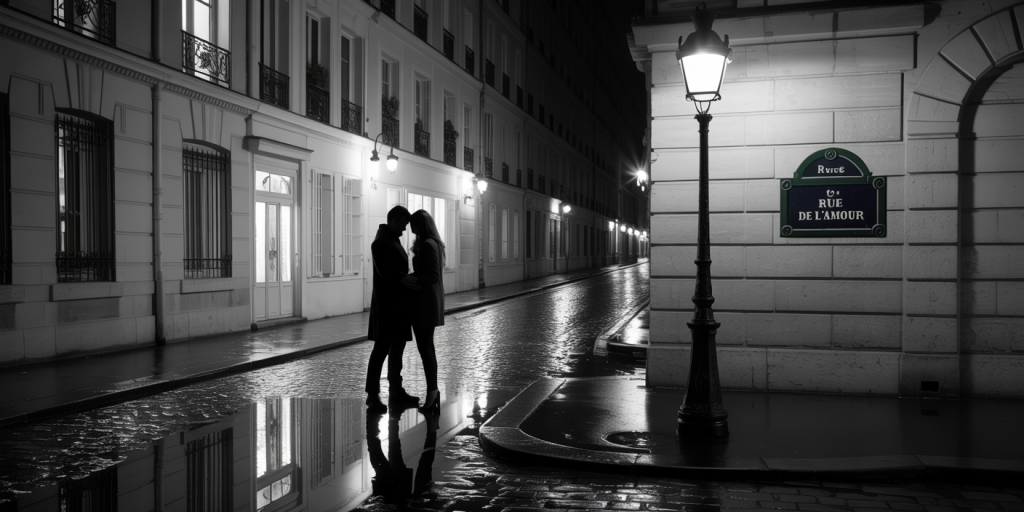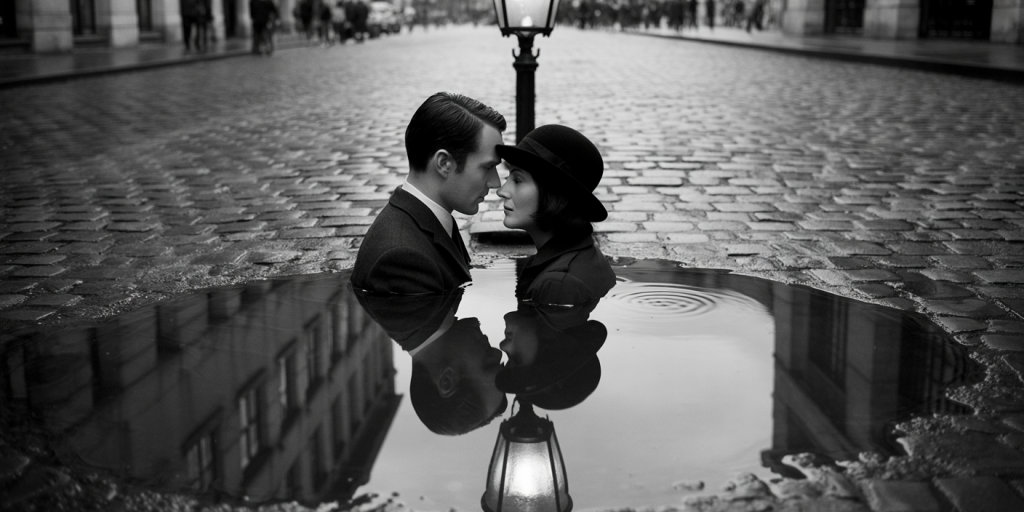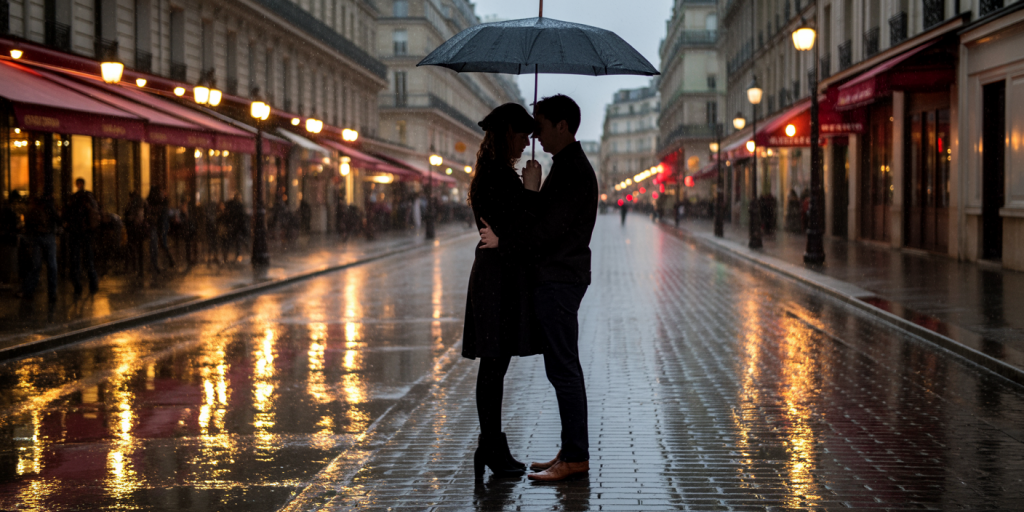Brassaï and the Lovers’ Reflection in the Puddles of Paris
Night falls like silk over the cobblestones of Montmartre. A soft rain drapes the city in melancholy, awakening the shimmer of ancient streets. And there, where the puddles swell like tiny lakes of memory, the silhouettes of lovers bloom—fugitive, trembling, captured for eternity.
Brassaï did not photograph Paris. He revealed its soul. His lens did not search for spectacle; it found confession. In the rain-soaked corners of the city, where reflections live more vividly than forms, he captured the quiet poetry of lovers leaning into each other, as if the world beyond their mirrored image no longer mattered. In a time suspended between raindrop and heartbeat, Brassaï taught the pavement how to dream.

Table of Contents – Echoes Beneath the Rain
- The Pavement as a Mirror of Intimacy
- Reflections More Real Than the Flesh
- When Rain Becomes a Language
- Lovers Drawn in Light and Liquid
- Faces that Melt into Puddles
- Shadows as Extensions of Desire
- Gaslight and the Glow of Hidden Feelings
- Monochrome as Emotion
- Textures of Damp Stone and Skin
- Framing the Unseen with Tenderness
- Intimacy Between Silhouettes
- A City Draped in Secrets
- Silent Kisses and Echoed Steps
- The Geometry of Romance
- Technique as a Whisper
- A Photograph as an Embrace
- Memory Etched in Water
- Paris as a Stage of Soft Reveries
The Pavement as a Mirror of Intimacy
In Brassaï’s world, the pavement is no longer background—it is revelation. Each stone, each line of mortar, becomes a reflective witness. The wetness left by Parisian rain does not merely shimmer—it listens.
He elevates the ground into a canvas where passion paints itself in shadows and contours. The viewer doesn’t just look down; they fall into it—into longing, into union, into shared solitude.
Reflections More Real Than the Flesh
Sometimes what we see in a puddle feels more authentic than what stands above it. Brassaï understood that. He often photographed not the people, but their reflected selves—distorted, fluid, romantic.
This technique does more than surprise. It disarms. It bypasses identity and delivers essence. The reflection becomes the truth, while the body becomes suggestion.
When Rain Becomes a Language
The drizzle in Brassaï’s photographs is not merely meteorological. It is emotional climate. Rain becomes the script on which his lovers perform.
It writes in rivulets, in ripples, in the softened glow of lamplight. The droplets are commas. The puddles, parentheses. And his camera? A translator.
Lovers Drawn in Light and Liquid
These are not posed couples. They are apparitions of love—drawn in outlines of light, rendered in the brushstrokes of wet asphalt.
Brassaï captures not their features but their bond. The closeness. The lean of heads. The symmetry of yearning. They are not actors. They are echoes.
The Dance of Stillness
There’s a quiet choreography in his images. A lean here, a pause there. Yet nothing moves. That’s the paradox. Stillness, charged with kinetic memory.
Every captured couple seems on the cusp—of a kiss, of a confession, of a goodbye. The moment is both arrival and retreat.
Faces that Melt into Puddles
We do not see the faces clearly. And that is the point. Identity dissolves in Brassaï’s vision, because what matters is the emotion between.
The lovers’ features blur, soften, and blend into the texture of water and light. The lack of detail sharpens our focus on the sentiment.
Shadows as Extensions of Desire
Shadows, in Brassaï’s hands, are not opposites of light. They are partners. They extend the lovers. Amplify their closeness. Double their presence.
Each elongated form cast into wet cobblestone is not a distortion but an exaggeration—of closeness, of longing, of merging.
Gaslight and the Glow of Hidden Feelings
The soft haze of gaslamps cloaks his images. It creates not just visibility, but atmosphere. The light is never sharp. It’s enveloping.
This glow lends warmth to the wet night. It’s not illumination—it’s a caress. The light loves the lovers as much as they love each other.
Monochrome as Emotion
Black and white in Brassaï’s work is not aesthetic—it’s affective. The absence of color makes emotion louder.
The blacks are heavy with yearning. The whites, fragile as breath. Together, they weave a chiaroscuro not of form, but of feeling.
Textures of Damp Stone and Skin
There is an aching tactility in his photographs. You can almost feel the slick cobblestones, the brushed fabric of a coat, the soft compression of bodies leaning in.
Texture here is not visual—it is sensual. We touch with our eyes. We feel through grain and grayscale.

Framing the Unseen with Tenderness
Brassaï’s framing is gentle. He does not intrude. His compositions are respectful. They feel like glimpses, not captures.
The intimacy lies not just in the subject, but in the way it is approached. No exploitation. Only empathy. Only poetry.
Intimacy Between Silhouettes
Often the lovers are reduced to outlines. But these outlines pulse with emotion. In their minimalism, they are maximal.
The closeness, the lean, the merged darks—all of it signals emotional proximity. The silhouette becomes a love letter.
A City Draped in Secrets
Paris, in Brassaï’s gaze, is not the city of lights—it’s the city of whispered truths. Alleyways curl like secrets. Puddles whisper confessions.
His city is nocturnal, hushed, tender. It wears its silence like perfume. And we inhale its mystery with every glance.
Silent Kisses and Echoed Steps
You can almost hear the echo of steps, the hush of a coat sleeve brushing against another, the sound of a kiss not given, but remembered.
Brassaï’s photos are not loud. They hum. They murmur. The silence is never empty—it’s full of suspended breath.
The Geometry of Romance
His compositions are not haphazard. There is deep geometry in his frames. Angles of embrace. Arcs of shoulders. Diagonals of reflection.
Love, in Brassaï’s world, is not chaotic—it is designed. Like a stanza. Like architecture softened by rain.
Technique as a Whisper
Brassaï’s technical mastery hides in softness. His exposures, his timing, his prints—they are precise. But they never show off.
His photographs whisper. They never declare. The artistry lies in restraint. He holds back so the moment can speak.
A Photograph as an Embrace
Each photo is a gesture of holding. A suspension of time. A preservation of feeling.
He doesn’t capture couples. He keeps them. Tenderly. As one might fold a letter in a drawer, or place a dried flower in a book.

Memory Etched in Water
Puddles evaporate. But Brassaï’s images remain. The memory becomes permanent. Liquid love made archival.
Even as time dries the streets, his photographs continue to shimmer—with all that was once felt there, in a forgotten puddle.
Paris as a Stage of Soft Reveries
For Brassaï, Paris is not a city—it’s a stage. Each streetlamp is a spotlight. Each puddle, a spotlighted floorboard.
And the lovers? Actors in a dream. The audience? Us—watching from the quiet shadows, remembering our own nights of reflected hearts.
FAQ – Questions and Answers
Who was Brassaï?
Brassaï (1899–1984) was a Hungarian-French photographer known for capturing Paris at night. He elevated everyday life into timeless poetic imagery, especially focusing on nocturnal streets, lovers, and reflections.
Why are reflections so central in his work?
Reflections allow Brassaï to explore duality, intimacy, and the fluidity of identity. They blur reality, enhance mystery, and turn ordinary scenes into lyrical compositions.
What makes his lovers’ series unique?
Rather than posing couples, Brassaï captured genuine, fleeting moments—glances, touches, embraces—often through reflections. He celebrated love in its quiet, unguarded beauty.
How did he achieve the atmospheric quality of his night photos?
Using long exposures, careful framing, and available light (mostly streetlamps), Brassaï created images that glowed from within. His technical finesse served his poetic eye.
Why does black-and-white matter here?
Color might have distracted from emotion. Monochrome allowed Brassaï to emphasize form, light, and mood, creating timelessness and enhancing the lyrical tone.
Final Reflections – Where Love Meets Rain
Brassaï did not take photographs of love—he listened to its silence. He crouched by the puddle and waited—not for the kiss, but for the breath before it. For the soft murmur of closeness beneath a Parisian rain.
In a city already mythologized, he found the unspoken moments. The glances too quick to notice. The embraces too tender to last. And in capturing them, he gave them eternity—not as spectacle, but as symphony.
Through Brassaï’s lens, we remember that love is not always loud. Sometimes, it is a shimmer on wet cobblestone. A silhouette in a puddle. A photograph that never dries.
